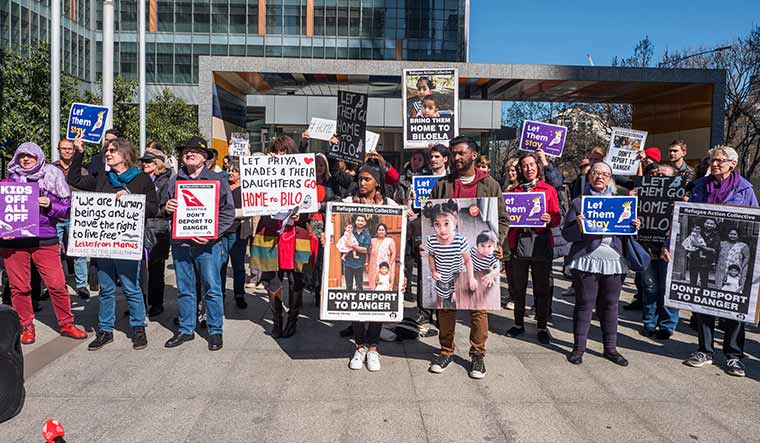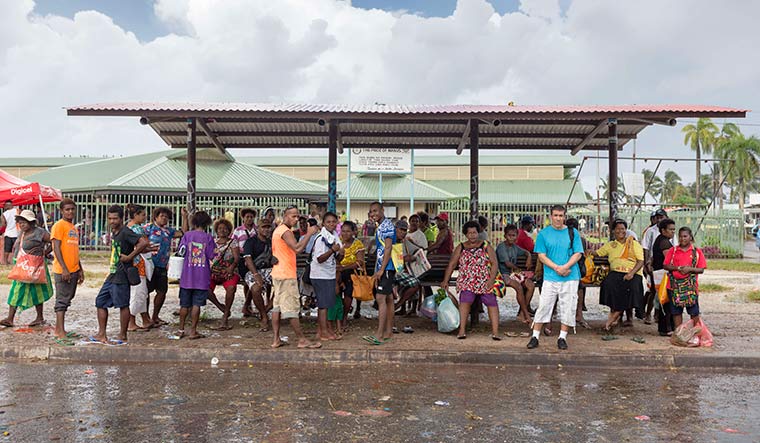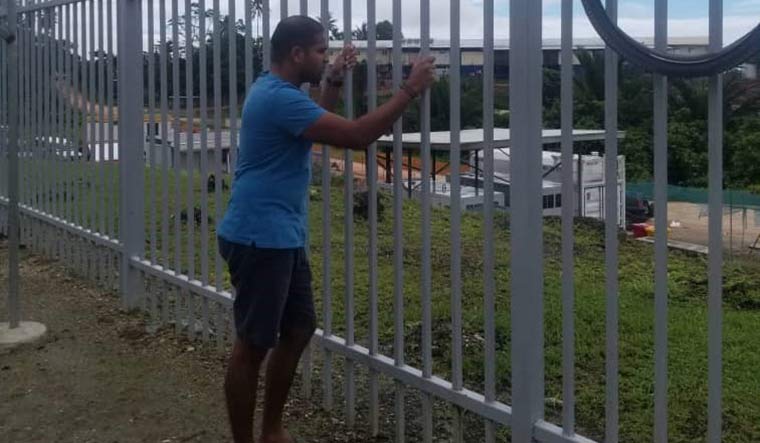Australia is a sought-after destination for Indian students, travellers and skilled migrants from India, but it is a little-known fact that Indians also come here to seek asylum.
According to the United Nations High Commission for Refugees (UNHCR), population statistics based on data received from the Australian government, 51 asylum seekers from India in Australia were found to be refugees in 2018. Many of them are waiting to be resettled; others have been waiting for their asylum claims to be processed, some for six years or more, in Australia’s offshore immigration facilities in the Pacific island nations of Papua New Guinea (PNG) and Nauru.
Nisar Ahmad Haji, an Indian national from Kashmir who was processed as a refugee in October 2015, is still waiting to be resettled. A refugee is someone, who has been recognised under the 1951 United Nations Convention Relating to the Status of Refugees, to be a refugee.
“I was 25 years old [in 2009] and was helping my father run our small general store in a village near Srinagar,” he told THE WEEK from Nibok Refugee Settlement in Nauru. “There was growing unrest in the valley. Someone told my father about jobs in Malaysia. He wanted to give me the best opportunity in life, so my parents sacrificed everything to buy a flight ticket to send me to Malaysia in December 2009.”
Nisar worked in Malaysia for two years, when “some people” talked him into going to Australia. For a few thousand dollars, they put him on a boat to Indonesia, from there he endured three weeks on another boat to reach Christmas Island, an Australian territory in the Indian Ocean south of Java (Indonesia). Like hundreds of other asylum seekers, Nisar had to endure rough seas, squalor, disease and hunger on a rickety boat for weeks.
“Growing up in the Himalayas, I had never seen the sea,” said Nisar. “I was terrified and became very sick. After a few days on Christmas Island, the Australian government sent us to Nauru, where I have been for the past seven years. During this time, I lost both my parents and three uncles. They had hoped that if I had a good career, I would be able to help my younger sister and brother, who are still in Kashmir. I have not been able to talk to them since the lockdown following the abrogation of Article 370 [on August 5].”
His family had been upset because they believed he had made it to Australia and he was living the good life, but not supporting them. A sentiment that resonates with many of the asylum seekers and refugees THE WEEK spoke to. They all concealed their real situation from their loved ones because they did not want to make their families anxious.
“We survive on the fortnightly allowance provided by the Australian government. We have no study or work rights. The people, culture and climate in Nauru are completely different from Kashmir. I long for noon chai, Kashmiri wazwan and the abundance of fresh fruits. Here, I can’t afford to buy even a slice of watermelon,” said Nisar, who has married a Nauruan nurse.
He said his wife could not get a job because many Nauruans do not like refugees. “A few months ago, a local man punched me, breaking my arm and nose,” he said. Nisar is still waiting to receive proper medical treatment for his various ailments. He longs to be free to pursue higher education, get a good job and help people in need so they don’t have to leave their home and undergo the suffering and loss that he has.
According to the Refugee Council of Australia, there were about a dozen men from India in Australia’s offshore immigration facilities in Papua New Guinea and Nauru as of September 2018. An asylum seeker is defined as someone who is seeking international protection, but whose claim for refugee status has not yet been determined.
Said Ram Singh (name changed), an asylum seeker from Punjab: “I was 24 years old and working on a farm in Punjab when an ‘agent’ promised me a better life. For about Rs10 lakh, the agent sent me by flight to Indonesia and then another agent put me on a boat to Australia.”
Most asylum seekers try to reach Australia on boats from Indonesia. often paying large sums of money to people smugglers, who are individuals or groups that assist people to illegally enter a country by providing air or sea access.
“I was one of 150 people who, in July 2013, reached Christmas Island,” said Ram. “I was then transferred to an immigration detention centre on Manus Island in Papua New Guinea. I have spent over six years in detention, wasting the best years of my youth. I am willing to settle in any country that would accept me. I want freedom from this misery.” The anguish and despair palpable in his voice.
Asylum seekers like Ram say they do not want to be named or cite reasons for leaving India because their claims are under process. Another asylum seeker reportedly from rural Uttar Pradesh said, “I used to watch cricket and I had seen beautiful videos of Australia. I was 19 years old when I met someone on Facebook who said he could send me to Australia. My father raised funds to pay this ‘someone’, who arranged my flight to Indonesia and then put me on a tiny, overcrowded fishing boat. I was terrified as it frequently rained and there was little food or drinking water. We didn’t think we would make it to Christmas Island. It was December 2013. From [Christmas Island], we were sent to Manus Island. I had dreamt of having a bright future in Australia. Instead, I have spent the past six miserable years in detention.”
Ian Rintoul, spokesperson for the Sydney-based Refugee Action Coalition, said most refugees from south Asia were seeking asylum on the grounds of political persecution. “For those from India, it can be personal conflicts with criminal gangs, which put their lives at risk, or religious or ethnic reasons,” he said.
These men have spent the most productive years of their lives languishing in boredom and isolation, torn away from their families and familiar surroundings. After paying such a heavy price, they want freedom, but they do not want to return to India. In June this year, Ravinder Singh from Punjab, who had arrived by boat in 2013, set himself alight in his room at Hillside Compound, one of the three immigration facilities on Manus Island, now closed. Ravinder survived, but his face and hands were severely burnt.
Indefinite detention of asylum seekers has caused widespread psychological harm, argue refugee and human rights advocates. “We have had over 120 cases of self-harm and attempted suicide since May this year,” said Rintoul. “There was a desperate situation in these detention centres.”
“Since mid-August, the refugees have been moved to several hotels in Port Moresby, which are strictly guarded with restrictions on visitors and strict limits on times allowed out of the hotel,” said Rintoul. “This is a hasty attempt by Australia and PNG immigration to be seen to close Manus detention centres, but the refugees are not free. Fifty-three men have been held incommunicado in the high-security detention centre annexed to Bomana prison in Port Moresby. There are no resettlement arrangements, and nothing in place to meet the needs of hundreds of people traumatised by years of brutality in detention. We still have 288 people on Nauru and 306 in PNG.”
Gripped by anxiety and fear of an uncertain future, many asylum seekers rarely go out of their hotel rooms. Thrice a day, they queue up to get their fixed portion of food, which they take to their rooms and eat. Every room has a television set, but no reception. There is no access to books or entertainment. They venture outdoors only when absolutely necessary as Port Moresby has a high crime rate. Almost all of them have cellphones, and use WhatsApp to stay in touch with family and friends.
Australia, a nation of migrants, has one of the most stringent policies against illegal immigration in the world. Under Australia’s Operation Sovereign Borders, a military-led border security initiative started in 2013, anyone arriving on a boat without adequate documentation is put in indefinite detention in Nauru or Papua New Guinea.
“In August and September 2012, Australia had concluded agreements with PNG and Nauru establishing joint processing arrangements, whereby some asylum seekers arriving in Australia by boat were sent to those countries to be processed and wait for an indeterminate amount of time before being settled back in Australia or elsewhere,” said Madeline Gleeson, senior research associate at the University of New South Wales’ Kaldor Centre for International Refugee Law. “In 2013, these arrangements were superseded with the signing of new agreements, according to which all asylum seekers arriving in Australia by boat without visas were to be sent offshore, and processed there under joint arrangements, but none would be permitted to settle back in Australia, even if found to be refugees.”
According to Gleeson, the arrangements made provisions for the possible permanent settlement of refugees in the two island nations. “Since 2014, if any, new arrivals have been sent offshore under these arrangements,” she said. “Instead, for the past five years, asylum seeker boats have been intercepted and turned around at sea, under Operation Sovereign Borders.”
Under Australian law, a person can be held indefinitely in immigration detention until they are granted a valid visa or they choose to leave the country or Australia finds another country to which they can go. Refugee and Human Rights activists have been relentlessly campaigning to put an end to this punitive policy of mandatory detention, which they say breaches Australia’s many international legal obligations―the 1951 UNHCR’s Refugee Convention and the 1967 Protocol relating to the Status of Refugees.
“The Australian government had been spending a billion dollars a year since 2013 in keeping hundreds of people unlawfully detained in these centres,” said Rintoul. “More than 90 per cent of these people have already been processed as refugees and should be immediately resettled.”
Shamindan Kanapathi, who was 21 when he left Sri Lanka because of the persecution of Tamils, has been recognised as a refugee. “There is an all-pervading sense of desperation and hopelessness,” he told THE WEEK from PNG. “We had been living in indefinite detention since 2013 with no rights to study or work. We have now been moved to a hotel in Port Moresby, but my future still hangs in the balance. We are just seeking refuge in a safe country”.
According to Australian Border Force Immigration Detention and Community Statistics Summary (31 July 2019), there were 1,342 people held in immigration detention facilities in Australia; 58 of them were from India. According to the UNHCR Population Statistics based on data received from the Australian Government, at the start of 2018 there were approximately 2,342 pending protection visa and merits review applications made by Indian asylum seekers in Australia. Another 1,920 protection visa and merits review applications were lodged during 2018. However, the Indian High Commission and Consulates in Australia said they had not received any request from Australian authorities in the past years regarding asylum-seekers from India.
“Those who are found to be owed protection are not granted permanent protection and cannot rebuild their lives. They live with constant threat of detention, and having to renew temporary protection visas, which interfere with their ability to find secure work and study. The process forces people to depend on charity or exploitative work to survive. Entire families face extreme poverty and homelessness,” said a spokesperson for the Asylum Seeker Resource Centre.
Habiburahman is a Rohingya who was forced to leave his home in Myanmar’s Rakhine State because of sectarian violence. He arrived in Australia by boat in 2009, and spent time at several immigration detention centres before his refugee status was cleared. The process took 32 months. He is now waiting for a permanent protection visa.
“All protection visa applications are assessed against the relevant framework in Australia’s migration legislation,” said a spokesperson for Australia’s department of home affairs. “Protection claims are assessed individually, by taking into consideration the particular circumstances of the applicant and information on conditions in the country from which the applicant seeks protection.”
People can claim asylum after they have come to Australia on a valid visa, for example, as a student or tourist. In 2017-2018, there were 27,931 people seeking asylum by plane, but only 1,425 grants. In the past five years, the main nationalities seeking asylum by plane include those from India and Pakistan.
Abdul Razzaq, who hails from Mansehra Abbotabad in Pakistan’s Hazara region, came to Australia as an international student in 2010, accompanied by his wife. “After my father passed away, my life was under threat if I returned home,” he said. “So we applied for a temporary protection visa in 2013.”
Razzaq and his wife are currently on ‘bridging visa E’—or BVE, which enables them to remain lawfully in Australia while their immigration status is resolved. According to the Department of Home Affairs’ Illegal Maritime Arrivals (IMAs) on BVE June 2019 report, there were 56 Indian IMA BVE holders.
“The BVE doesn’t give us the right to work, study, travel overseas or access Medicare (the government-funded health care scheme). We suffered from depression and my wife has several chronic health problems. We live in constant fear, stress and anxiety. What if we are asked to return to Pakistan,” said Razzaq, who volunteers for high school sports through Cricket Australia’s A Sport for All community ambassadors programme.
-------------------------
NO SAFE PASSAGE
On September 26, the US Immigration and Customs Enforcement released Ajay Kumar, a 33-year-old from Haryana, from a detention centre in El Paso, Texas. Four days later, they released Gurjant Singh, his friend and fellow Indian detainee.
The duo had been in detention for a year, even though they had not been charged with a crime. ICE officials said they had entered the country illegally, and that their asylum applications were rejected by a judge. Kumar and Singh had appealed the decision, and they wanted ICE to release them while their appeals were being heard.
Demanding freedom, they went on a 70-day hunger strike. ICE officials tried to force-feed them several times, but apparently failed. The officials finally agreed to release them on September 21.
On September 30, Kumar and Singh stood outside the detention centre, their hands folded in greeting as journalists asked them about their ordeal. Both the men had lost nearly 20 kilos each, but had not lost hope that the US government would grant them asylum. “I have been waiting a long time for this—to be free,” said Kumar. “I would rather starve to death in custody than be deported back to India.”
The duo says they faced death threats because of their affiliation to political parties that are in the opposition in India. Said Singh’s attorney Jessica Miles: “He came to the US seeking asylum and we have failed him every step of the way. He was denied a bond by an immigration judge known for bond denials. He was then denied asylum by the same judge. Now he seeks justice at the 10th circuit court of appeals, which I hope he will finally receive.”
The US Border Patrol has apprehended more than eight lakh undocumented migrants this year. Nearly 9,000 Indians were reportedly apprehended while trying to cross the US’s southwest border in 2018—up from just 77 in 2008. The number of Indian asylum-seekers in North America has also gone up—nearly 34,000 Indians applied for asylum in the US and Canada last year.





